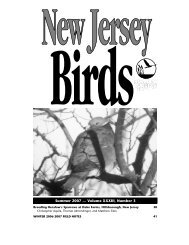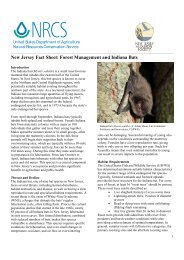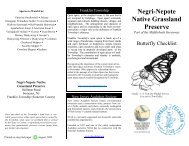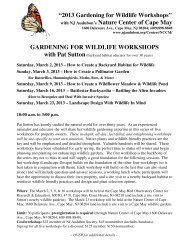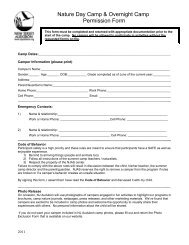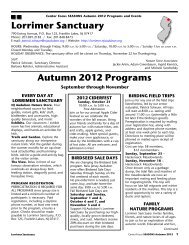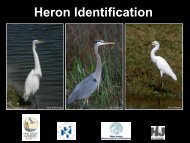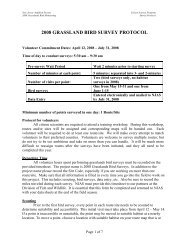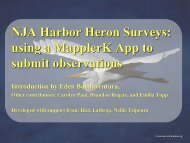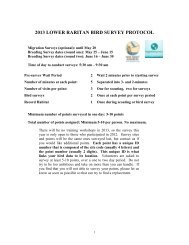Birding for Boaters - New Jersey Audubon Society
Birding for Boaters - New Jersey Audubon Society
Birding for Boaters - New Jersey Audubon Society
Create successful ePaper yourself
Turn your PDF publications into a flip-book with our unique Google optimized e-Paper software.
Sanderling – the classic gray andwhite sandpiper often seen playing“chicken” with waves along ourbeaches, this Arctic-nesting shorebirdcan be seen along the coastfrom July to May.Piping Plover (Endangered) – thisbeach nester is a sparrow-sizedshorebird that arrives in March anddeparts in September. Foundalmost exclusively on ocean sidebeaches and sand flats, this bird’scamouflaged coloration makes itdifficult to see.Laughing Gull – abundant alongthe coast, this smallish gull is afamiliar sight anywhere along the<strong>Jersey</strong> shore from March toNovember. Its distinctive“ha’ha’ha” call gives the bird itsname. The largest nesting colonyin the world is near Stone Harbor.Herring Gull – a common yearroundresident of the shore, thisspecies takes four years to reachmaturity and shows a variety ofplumages. Young birds are mostlybrown, slowly changing to thewhite-headed and gray-backedadult over time.Great Black-backed Gull – thelargest gull in the world, thisspecies’ populations increasedgreatly in NJ. Young birds arecheckered brown and white whileadults are black-backed and whitebodied with a powerful yellow bill.Least Tern (Endangered) – this littletern nests locally from SandyHook to Cape May. It can be separatedfrom other terns by its smallsize and yellow bill.Common Tern – smaller and moregraceful than gulls, this speciesnests on coastal islands and protectedbeaches. They hunt <strong>for</strong>small fish by hovering over thewater, then diving. Note the pointywings, <strong>for</strong>ked tail, and black capthat help distinguish it from gulls.Use the check boxes torecord your bird sightings!Royal Tern – this species is largerthan Common Tern and has asmall black crest and orange bill.After nesting in the mid-Atlanticthis species spends late summerand fall along the <strong>Jersey</strong> shore.They feed on small fish by aerialdives.Black Skimmer (Endangered) –best known <strong>for</strong> its feeding style.Flying just above the surface, theycut the water with their elongated,knife-like lower bill. This speciesnests on undisturbed beaches andremote islands in our coastalwaterways. Listen <strong>for</strong> their barking call while the birds<strong>for</strong>age around sunrise and sunset.MarinasBarn Swallow – often nestingaround old buildings and docks,these small, insect-eating birdshave a <strong>for</strong>ked tail, orange underparts,and a blue back.Belted Kingfisher – easily recognizableby its blue upperparts, longbill, and shaggy crest, this birdperches conspicuously near waterand hover-hunts <strong>for</strong> small fish.Boat-tailed Grackle – found onlyalong the coast, this large memberof the blackbird family nests in saltmarshes and eats small fish andcrustaceans. During winter they<strong>for</strong>m large flocks and may befound in residential areas, marinas,and cities.Fish Crow – almost identical toAmerican Crow, these birds canbe distinguished by their nasal“uh-oh” call and coastal distribution.Fish Crows are commonscavengers along <strong>New</strong> <strong>Jersey</strong>’scoastline.Turkey Vulture – with a featherlessred head, huge silvery wings,and v-shaped flight silhouette, thisscavenger is a common sight anywherealong the <strong>Jersey</strong> Shore.They locate food using a keensense of smell.



